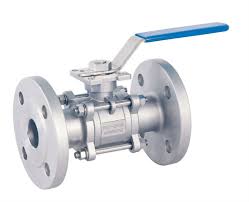Flanged Ball Valve with lever 4 inch 300 LB

Standards
Design and Manufacture: API 6D
Face To Face: ASME B16.10
Butt Welded Ends: ASME B16.25
Test And Inspection: API 598
The Application of Flanged Ball Valve
Flanged Ball Valve is a versatile and widely-used valve type in industrial applications. The 3 Flanged Ball Valve design, with its three-piece construction, offers easy maintenance and installation flexibility. Apollo Flanged Ball Valve is a popular choice among end-users, known for its reliable performance and durability. Cameron, a leading manufacturer of industrial valves, offers a comprehensive range of high-quality Flanged Ball Valve solutions to meet the diverse needs of process industries, ensuring efficient fluid control and superior system performance.
What Are The Types Of Flanged Ball Valve?
1. Full Port Flanged Ball Valve:
- Offers minimal flow resistance and pressure drop due to its full-bore design.
- Ideal for applications requiring high flow rates and efficient fluid handling.
2. Reduced Port Flanged Ball Valve:
- Features a reduced bore size compared to the full port design.
- Suitable for applications where space is limited or where lower flow rates are required.
3. Trunnion Mounted Flanged Ball Valve:
- Incorporates a trunnion-style design, providing enhanced stability and control.
- Commonly used in high-pressure and high-temperature applications.
4. Floating Flanged Ball Valve:
- Utilizes a floating ball design that allows for self-aligning and improved sealing.
- Ideal for applications with potential for piping misalignment.
5. Segmented Flanged Ball Valve:
- Features a segmented ball design, providing better control and throttling capabilities.
- Suitable for modulating flow applications and precise flow regulation.
What Is Flanged Ball Valve?
A Flanged Ball Valve is a type of industrial valve that features a ball-shaped closure mechanism and a flanged end connection. The ball valve design allows for quick, full-bore flow control by simply rotating the ball 90 degrees to open or close the valve. The flanged ends enable easy installation between pipe flanges, making the valve a popular choice for a wide range of industrial applications, including chemical processing, oil and gas, and water/wastewater treatment. Flanged Ball Valves are known for their reliable performance, tight shutoff, and low maintenance requirements, making them a versatile and cost-effective solution for fluid control in various industrial settings.
How to Select the Right Flanged Ball Valve?
Size and Port Configuration: Determine the required valve size and whether a full-port or reduced-port design is needed based on flow rate and system requirements. Trunnion-mounted or floating ball designs may be preferred for certain high-pressure or misalignment-prone applications.
Material Compatibility: Ensure the valve materials, such as the body, ball, and seals, are compatible with the fluid media and operating conditions, including temperature and pressure ranges.
End Connection Type: Verify that the valve’s flanged ends match the existing pipe flanges in terms of size, pressure rating, and flange standards (e.g., ANSI, DIN).
Actuation and Control: Consider the valve’s actuation method (e.g., manual, pneumatic, electric) and any additional control features required, such as limit switches or positioners.
Regulatory Compliance: Confirm that the Flanged Ball Valve meets any relevant industry standards, certifications, or safety regulations for the intended application.
Features of Flanged Ball Valve
Full-Bore Design:
Flanged ball valves often feature a full-bore design, allowing for unobstructed flow and minimal pressure drop, making them suitable for high-flow applications.
Tight Shutoff:
The ball mechanism in these valves can provide a tight, bubble-tight seal when closed, ensuring reliable isolation and zero leakage.
Easy Maintenance:
The simple, two-piece or three-piece construction of Flanged Ball Valves facilitates easy maintenance and repair, reducing downtime.
Corrosion Resistance:
The valve body and components can be manufactured using corrosion-resistant materials, such as stainless steel or specialized alloys, to withstand harsh operating environments.
Automation Compatibility:
Flanged Ball Valves can be equipped with automated actuators, allowing for remote operation and integration into automated control systems.
Compact Design:
The compact size and wafer-style configuration of Flanged Ball Valves make them well-suited for installations with limited space.
Versatile Application:
These valves are widely used in various industries, including oil and gas, chemical processing, water treatment, and power generation, among others.
Advantages and Disadvantages of Flanged Ball Valve
Advantages of Flanged Ball Valve:
- Quick Actuation: The ball mechanism allows for fast, quarter-turn operation, providing quick and reliable flow control.
- High Flow Capacity: The full-bore design of many Flanged Ball Valves offers low-resistance, high-flow capabilities.
- Tight Shutoff: The ball-and-seat sealing mechanism can provide a near-perfect, bubble-tight seal when the valve is closed.
- Compact Size: The wafer-style configuration of Flanged Ball Valves allows for a space-saving installation.
- Ease of Maintenance: The simple, modular design facilitates easy disassembly, inspection, and repair.
- Corrosion Resistance: Valves can be manufactured using corrosion-resistant materials for use in harsh environments.
Disadvantages of Flanged Ball Valve:
- Limited Throttling Ability: The ball mechanism is primarily designed for on/off control, with limited capabilities for precise flow throttling.
- Potential for Leakage: Improper maintenance or wear of the seals can lead to potential fluid leakage.
- Higher Cost: Flanged Ball Valves can be more expensive compared to some other valve types, especially for larger sizes.
- Limited Temperature Range: Depending on the valve materials, the operating temperature range may be restricted.
- Potential for Seat Damage: Frequent cycling or high-velocity flow can cause wear and damage to the valve seats over time.
The Specifications of Flanged Ball Valve
| Specification | Details |
|---|---|
| Type | Full Port Flanged Ball Valve |
| Ball Material | 316 Stainless Steel |
| Attachment Type | Flanged |
| Thread Standard | ANSI 150# |
| Thread Size | 2 inch |
| Body Material | 316 Stainless Steel |
| Safe for Use With | Water, Oil, Gas, Chemicals |
| Handle Type | Lever |
| Handle Material | Stainless Steel |
| Maximum Working Pressure (psi) | 285 psi |
| Maximum Working Pressure (bar) | 19.7 bar |
| Operating Pressure | 0-285 psi (0-19.7 bar) |

